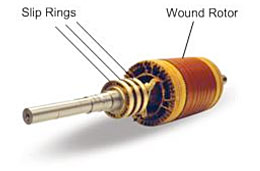Large wound rotor induction motors (WRIM) have been used in some industries for decades. In the cement and mining industries, high horsepower WRIMs are used on large grinding mills, where they have the advantage of controlled starting characteristics and adjustable speed capability. These motors are also used on large pumps in the water and waste industry.
A WRIM has a 3-phase wound stator that is usually connected directly to the power system. The rotor has a 3-phase winding, with the three terminals connected to separate slip rings, which are normally connected to a liquid rheostat or resistor bank. The rheostat is used for starting, and can be disconnected once the motor is up to speed. By changing rotor resistance with the rheostat, the motor speed can be changed. In the past the power dissipated in the rheostat was lost as heat; however, using a variable speed drive in place of the rheostat, the slip power can be recovered and returned to the utility supply, thus saving energy. Also, by using the drive to increase the power taken off the rotor, the motor speed can be reduced. As a bonus, by putting power into the rotor through the drive, the motor can be run above synchronous speed. The speed, of course, must be within the motor design limits.
 The slip power recovery system uses a state-of-the-art low voltage Pulse Width Modulated drive. This new implementation builds on the standard line of TMEIC low voltage induction motor drives used in process industries such as metal processing and paper making. The hardware is very reliable and familiar, and is appropriate for new or existing motors. The slip power is low voltage and only a small portion of the total motor power, so the drive required is low capacity and lower cost than a full size medium voltage drive.
The slip power recovery system uses a state-of-the-art low voltage Pulse Width Modulated drive. This new implementation builds on the standard line of TMEIC low voltage induction motor drives used in process industries such as metal processing and paper making. The hardware is very reliable and familiar, and is appropriate for new or existing motors. The slip power is low voltage and only a small portion of the total motor power, so the drive required is low capacity and lower cost than a full size medium voltage drive.
Calculations for a 5,000 hp WRIM running at 90% full speed show that the recovered energy is 360 kW worth over $200,000 per year.


